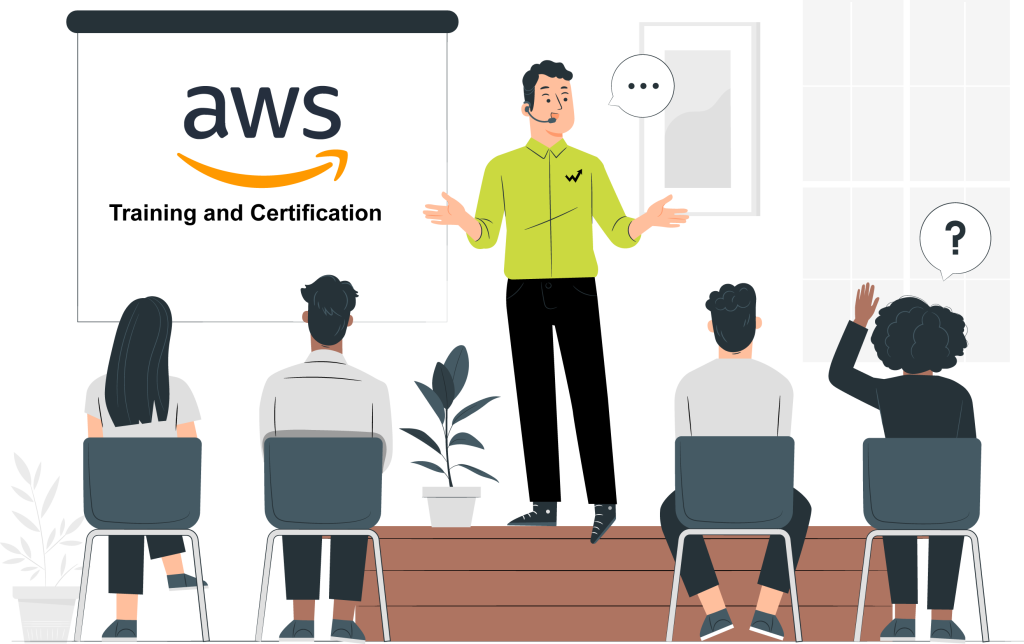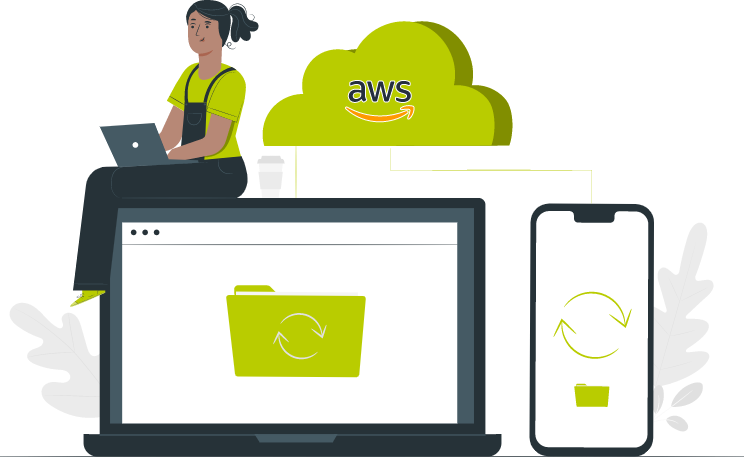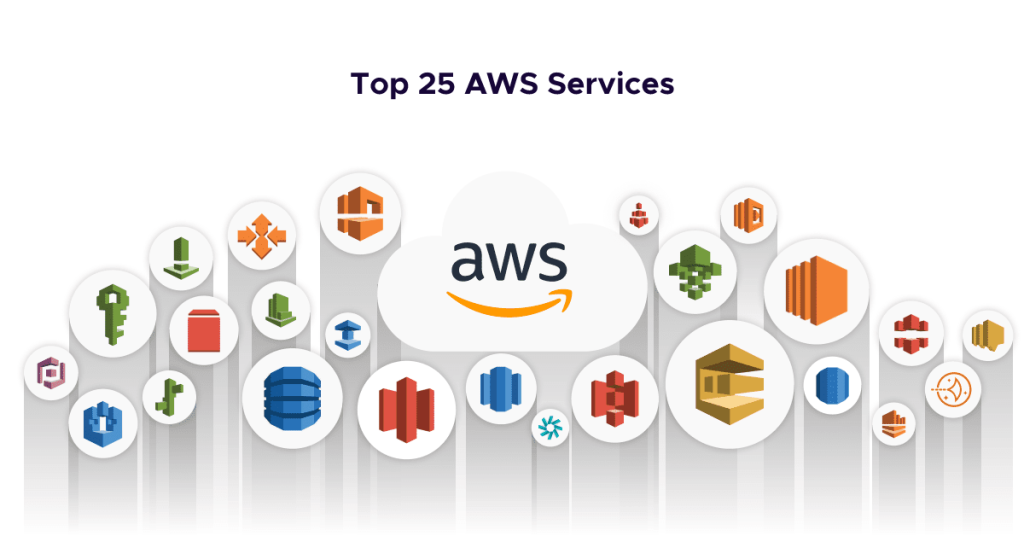AWS Certification Training Course
Passion driven instructors who believe in practical teaching


AWS Training
Are you ready to achieve your goals at your pace? Free digital training on AWS Skill Builder. We give You hands-on training experience in cloud computing training. Main Advantages of Cloud computing training you will be familiar with the concepts like cloud services, cloud virtualizations, Cloud deployment. Our Best Cloud Computing Training and syllabus is Structured by the industry’s best cloud computing experts to meet the industry standards.
AWS Overview
Amazon Web Services (AWS) is a cloud solution provider with an on-demand delivery for cloud computing resources on the internet. AWS offers 100s of integrated services built to optimize power, content delivery, database storage, and other business needs.
Amazon is the world-leading cloud provider, with a 32.4% market share, that enables you to pay-as-you-go on a relative scale. Meaning, the less you use, the less you pay; and the more you use, the less you pay per unit.
What does a AWS engineer do?
An AWS engineer is an IT professional who creates, maintains, and evolves an AWS cloud infrastructure for running applications. These infrastructures include production, test, and development environments. Now that we’ve established a definition of the job, we need to get into more detailed specifics of precisely what they do.
Be responsible for the planning, implementation, and growth of the AWS cloud infrastructure. Build, release, and manage the configuration of all production systems.
Manage a continuous integration and deployment methodology for server-based technologies. Work alongside architecture and engineering teams to design and implement any scalable software services. Ensure necessary system security by using best in class cloud security solutions. Stay current with new technology options and vendor products, evaluating which ones would be a good fit for the company
Implement continuous integration/continuous delivery (CI/CD) pipelines when necessary. Recommend process and architecture improvements
Troubleshoot the system and solve problems across all platform and application domains. Oversee pre-production acceptance testing to ensure the high quality of a company’s services and products


AWS Training Syllabus
- Overview of all basic commands
- Vim editor modes
- File System Hierarchy Basic Topics
- File and directories creation
- Grep
- Filter commands (head, tail, more, less)
- Creating users and groups
- Important files related
- Modifying, deleting users and group
- Linux permissions
- Basic permissions overview
- Software management
- Yellowdog update modifier(yum)
- Yum commands
- Different run levels
- Services and daemons
- Why Cloud and What is Cloud Computing?
- Identify the features and benefits of cloud computing
- Different types of Cloud Computing deployment model
- Public Cloud, Private Cloud, Hybrid Cloud
- Virtualization an essential in cloud
- Virtualization in Cloud model
- Different types of virtualization
- Hyper Visor benefits
- Different types of services and their difference in Cloud computing
- IaaS, PaaS, SaaS
- Importance of scaling in cloud computing
- Different types of scaling and its applications
- Issues we overcome using cloud and applications
- Cost model that we use in cloud computing
- Describe the features of AWS
- The features of the AWS marketplace
- Describe the features of Amazon Compute Services
- Describe the features of Amazon Storage Services
- Describe the features of Amazon Network Services
- Describe the features of Amazon Database services
- Describe various services in AWS
- Global infrastructure regions and availability zone.
- Create a free tier account in AWS and onboarding
- Introduction AWS management console
- Protect your AWS by a different authentication system
- Password policies set for users
- AWS User Account and Groups in detail
- Creating custom policies in AWS
- Introduction about Roles and their use
- Creating Roles and associating policies
- Creating programmatic access and management console access for users
- Associating policies to the user and groups
- Describe AMI and AWS Marketplace templates
- Launch a basic EC2 instance
- Different types of Instances Reserved, On-demand, Spot, Dedicated
- Security groups and tags for EC2 instance
- Public key, Private key introduction and protecting EC2 with keys
- Attaching and detaching EBS volumes
- Launch an ec2 instance from an AMI
- Create custom AMI and working with a different region
- Make use of Amazon EBS volume and create snapshots
- Manage the configuration of your application
- Deploying a new instance from the created AMI
- Get Started with Auto Scaling Using the Console
- Creating Launch configurations and make use of it for autoscaling groups
- Maintain a Fixed Number of Running EC2 Instances
- Dynamic Scaling
- The lifecycle of autoscaling
- Policies of autoscaling
- Introduction to Load balancer (ELB)
- Different types of Load balancer in AWS
- Application Load balancer
- Network Load balancer
- Classic Load balancer
- Migrating classic load balancer to new load balancer
- Components and types of load balancing
- Introduction to Load balancer (ELB)
- Different types of Load balancer in AWS
- Application Load balancer
- Network Load balancer
- Classic Load balancer
- Migrating classic load balancer to new load balancer
- Components and types of load balancing
- Understanding S3 durability and redundancy
- Introduction about S3 Buckets
- How S3 Uploading works and how to Download
- How to S3 Permissions
- How to implement S3 Object Versioning S3 Lifecycle Policies
- Storage Gateway
- Import Export
- S3 Transfer Acceleration
- Glacier storage
- Describing cloud front
- Creating a cloud front distribution
- Hosting a website of cloud front distribution
- Implementing global restrictions
- Configuring origins and behaviors
- Describe Hosted zones and Domain name understanding
- How to create hosted zones
- Hosting a website with a custom domain name
- Understanding routing policies
- Describing Security Practices for Cloud Deployment
- AWS Shared Responsibilities and Securities
- Importance of Cloud Trail
- Describing Trust advisor
- Introduction to Amazon Virtual Private Cloud (VPC).
- VPC Advantages and understanding IP addressing CIDR
- Default and Non-default VPC
- Different Components in VPC
- Describe, create, and manage Amazon Virtual Private Cloud
- Amazon VPC, Private Subnet, and Public Subnet
- AWS Networking, Security Groups, and Network ACLs
- Configuration and management of VPN connectivity
- Subnet and Subnet Mask
consequat.
- Introduction to RDS
- Different database services of AWS: Amazon RDS, Dynamo DB, Redshift, etc.
- Create MYSQL RDS Instance, Oracle RDS Instance, MS SQL RDS Instance
- Configuring the database
- Configuring backups
- Configuring the maintenance windows
- Connecting to the database
- Creating a dynamo dB
- Adding data manually
- Learn about strong and eventual consistency
- Calculating Read-write consistency
- Configuring alarms
- Knowledge on Cloud watch a monitoring service
- Create and Configuring Monitoring services
- How to perform Setting thresholds and Configuring actions
- Creating a cloud watch alarm
- Getting statistics for ec2 instances
- Monitoring other AWS services
- Configuring Notifications
- Integrating cloud watch with Autoscaling
- Knowledge on Cloud watch a monitoring service
- Create and Configuring Monitoring services
- How to perform Setting thresholds and Configuring actions
- Creating a cloud watch alarm
- Getting statistics for ec2 instances
- Monitoring other AWS services
- Configuring Notifications
- Integrating cloud watch with Autoscaling
- Troubleshooting EC2 instance
- Troubleshooting using Cloud watch
- Troubleshooting using ELB
- Troubleshooting by using Cloud front
- Backup and Disaster Recovery
- How to manage Disaster Recovery and Backups
- Best Practice for DR and Backups
- AWS High Availability Design
- An understanding of DevOps and the modern DevOps toolsets
- The ability to automate all aspects of a modern code delivery and deployment pipeline using:
- Source code management tools CVS, Git
- Build tools Apache ant, Maven
- Test automation tools J Unit
- Continuous Integration Tools Jenkins, Team city
- Configuration management tools Chef, Puppet, Ansible

AWS DevOps Salary in India
Fresher:
₹4,50,000 Avg.Base Salary (INR)
Experienced:
₹20,50,000
